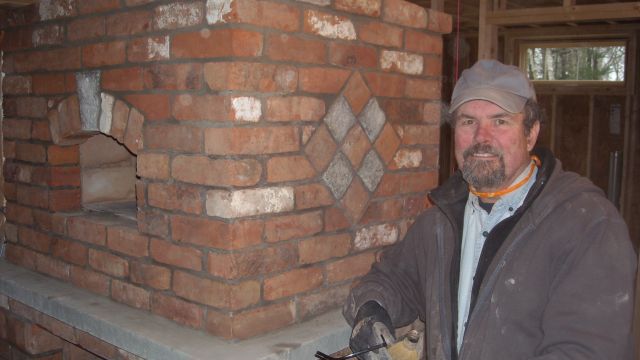The masonry heater revealed
Fireplaces and chimneys
For many of us, winters means lighting a fire to warm our bones and our souls. Perhaps one of the most opulent examples of a mason’s talents can be showcased in the work of a fireplace, chimney or masonry heater. Masonry heaters are more popular than ever and offer an ability to control the amount of heat being emitted. This can be a real asset in a home or business.
We wanted to learn a little more about masonry heaters, so we went to that industry’s most trusted source, the Masonry Heater Association of North America, www.mha-net.org. Masonry spoke with Stephen Bushway, president of the association. Following is what he had to say.
Masonry: Explain the difference between a masonry heater and a standard fireplace.
Stephen Bushway: Whereas a fireplace vents the smoke in an upward direction directly, in a masonry heater the gases circulate through firebrick or refractory lined passageways, shedding much of the heat en route to the chimney. For this reason, masonry heaters need to have doors on the firebox. This enhances combustion by limiting “excess” air and creating turbulence in the firebox. The firebox in a masonry heater is basically a box: The side walls are not splayed but are at right angles to the opening, further aided combustion by re-radiating heat back to the fire.
Masonry: How difficult is adherence to codes and standards, and why is it important to do so?
Bushway: Complying with building codes is no more difficult than with a standard fireplace. Because they are designed as radiant heaters, they are usually sited in the middle of an open area and help define spaces in an open floor plan – so proximity to combustibles is not an issue in that situation.
Masonry: In an increasingly environmentally friendly world, where do masonry heaters fit in regarding energy efficiency and sustainability?
Bushway: The answer to that question is “front and center.” As cordwood heaters, masonry heaters burn a renewable fuel source. And because they burn the fuel so completely, harmful emissions are relatively low. Not only are masonry heaters energy efficient, they are very fuel efficient and have a long life cycle (50 to 100 years is not uncommon). They make good economic sense. What really sets them apart from other heat sources is the quality of the heat. It is extremely even and gentle. They can be designed with heated benches as well. It really doesn’t get much better than that.
Masonry: What types of masonry products are masons using on masonry heaters? Are manufactured stone products appropriate to use on masonry heaters?
Bushway: The most common facing material is brick: tried and true. Natural stone and honed soapstone are also used, and concrete pavers are also options. The facing is the “battery” that stores the heat and delivers it gently over a long time curve, so should be three to six inches thick, depending on the climate. Thin stone can be used over brick or firebrick laid as shiners. Keep in mind, the facing layer is always separated from the core by an expansion joint.
Masonry: Do you think it’s important to keep the art and craftsmanship of masonry heaters alive? Are they still a popular choice in homes and other buildings?
Bushway: Masonry heaters are better suited to residential applications, because there is a connection that develops between the operator, the heater and the weather that you don’t often have in a commercial setting where the thermostat is the order of the day. As a custom masonry heater builder – and user of 23 years – I can’t think of a more rewarding activity. The goal of our organization is to educate the public to the benefits of masonry heating, so that the demand for them will continue to grow.
Originally published in Masonry magazine.
About the Author
Jennifer Morrell was the editor of Masonry magazine. She has 20 years of experience in the publishing industry as a writer and editor, covering such topics as real estate and construction, insurance, health care, relationships and sports. A graduate of The University of Georgia’s Grady College of Journalism, she earned a Bachelor of Arts degree in magazines and is an award-winning newspaper columnist.



















